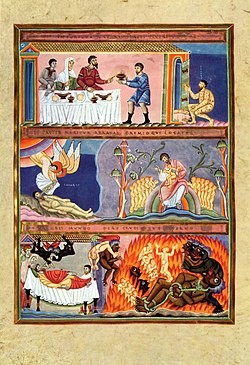Codex Aureus of Echternach
[6] The narrative scenes cover the Life of Christ, including many of his miracles, and preceding Luke his parables, which by this date was becoming unusual.
[8] The pages before Matthew take the story from the Annunciation to the "Feast in the House of Levi", and those before Mark cover miracles from the Wedding at Cana to the Samaritan thanking Jesus after Cleansing ten lepers (Luke 17:11-19).
[10] The style has been criticized for excessive interest in decorative effect: it "produced some vigorous and cheerful patterns, as in the St Luke, but it could descend to fussiness, as in the Christ in Majesty, where the strength of the composition has been frittered away by the ornamental vagaries of the Echternach artist.
This weakness was even more apparent in the evangelist 'portraits', where the ornamental bands of the Sainte-Chapelle Gospels are degraded into decorative garrulity, and there is so little weight and structure under the draperies that they might be covering mere inanimate cushions.
Thinner gold bands set with small pearls run along the diagonal axes, further separating the relief images into compartments, and creating an "X" that may stand for "Christ"; an "X" in ash was traced on the floor of a new church in the ritual of its consecration.
[14] The general arrangement of the cover may be compared to others of the period – for example, that of the Codex Aureus of St. Emmeram of about 870, which probably forms part of the same tradition descending from the school of Reims in Carolingian art, as shown by the style of the relief figures.
They offer a foretaste of the bejeweled nature of the Celestial city, and particular types of gem were believed to have actual powerful properties in various "scientific", medical, and magical respects, as set out in the popular lapidary books.
[20] A highly plausible suggestion however[21] has been made by Gunther Wolf, namely that the front cover was commissioned really for Echternach (to Archbishop Egbert, while meeting him at Christmas 988 in Cologne) by Empress Theophanu (and Otto III) out of religious gratitude for her recovering of the illness that struck her at the end of the summer of 988 at Lake Constance; her adoration for Saint Willibrord, as shown by former gifts to Echternach, in that case was an additional motive in the perspective of the 250th anniversary of his death (November 7, 739 AD).
[22] It is thought that this is the manuscript shown to Henry III, Holy Roman Emperor when he visited Echternach with his mother Gisela of Swabia (d. 1043), which so impressed him that he commissioned similar works from the abbey, notably the Golden Gospels of Henry III, which he presented in 1046 to Speyer Cathedral, the burial-place of his dynasty.
It was decided to sell it but the then duke was keen to keep it in Germany, and the German Federal government and the provinces or Länder contributed the funds jointly, with Bavaria in the lead, as its new home was to be the Germanisches Nationalmuseum in Nuremberg, where it remains.




